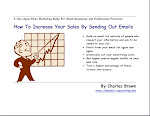Book Review - The New Rules of Marketing & PR (Part Two)
Posted by Charles Brown at Wednesday, July 16, 2008 The New Rules of Marketing & PR
The New Rules of Marketing & PR
With my apologies, this article is a couple of weeks over due, but I have been busy with several other writing projects.
I had promised a second part to my review of David Meerman Scott's wonderful book, "The New Rules of Marketing & PR."
If you recall from part one, Mr. Scott experienced an all-too-typical example of the wrong way to market when he went online to gather information about buying a new car. All three of the big US automakers' web sites began with the assumption that he was ready to buy now when he was still at the information-gathering stage.
He was assaulted with TV-style broadcast advertising with one-way messages focused on price.
Compare this approach to what he calls the new rules and how you and I as marketers can implement them.
The first step Mr. Scott suggests is to create "Buyer Personas" for your target demographics. In other words, break each visitor to your web site, each person who may eventually buy your product, into distinct groups based upon what each group of people want and need and what information they seek, regardless of whether this information will lead them directly to make a decision to buy.
For example, political campaigns have long targeted groups they call "Soccer Moms" and "NASCAR Dads." By singling these groups out from the electorate, they can identify what concerns these groups and what they will base their votes upon. Also by giving these "Buyer Personas" names, they make them real to the marketers involved in the campaign (and let us not for a moment think that a political campaign is not a marketing effort).
Suppose the car companies had done this when they had built their web sites. They would have realized that not every visitor was in a "buy now" mode. They would have realized there were many who wanted to simply gather information, get user generated feedback, check out safety, reliability and fuel economy information. They also could have treated different visitors as having distinct wants and needs.
Instead, they thought of all their visitors as a single entity. Don't you think that NASCAR Dads and Soccer Moms would have different motivations they could have appealed to?
Once you have create profiles for all the distinct "Buyer Personas" that have an interest in your web site or your company, Mr. Scott lays out one of the main themes of his book: "Think Like a Publisher."
Thinking like a publisher means to create content and information that would be of benefit to these Buyer Personas. This does not mean product information or sales content, but to simply understand what information could benefit these groups.
For example, what content can you create that would solve problems for your identified Buyer Personas without mentioning your company or products or services?
Some examples Scott uses is an automobile tire company that could produce an ebook or video on how to drive safely over snow and then offer it free on your web site, on YouTube or to give it free to auto clubs or drivers' education schools.
Another example could be a catering company that could produce content on how to plan a wedding reception or a dinner party.
Notice that all of these address problems for certain identifiable groups of buyers without being overt sales pitches. Having said this, however, this kind of non-selling can often be the most powerful selling tool you can create because it positions you as an expert (an unselfish expert) in your field.
Another very interesting example he cites is a company called The Concrete Network. A "brick and mortar company if ever there was one, the Concrete Network diligently produces how to information, problem solving information and media releases that address the needs of both their b2b and b2c (sorry, "business to business" and "business to consumers") buyer personas.
These include buyer guides on all sorts of home improvement projects and a Find-A-Contractor service that links homeowners to builders on 22 different specialties in 192 metropolitan areas in the U.S. or Canada.
Does this content always lead directly to a buying decision? No, but they do imply a generosity of spirit in these companies.
Several years ago, during the late 90s dot.com meltdown, I volunteered to do career counseling for a group of downsized managers and executives. One of the first things I had my classes do was to think of themselves of solutions to specific problems.
One by one, these folks all "got it" and it transformed their thinking from being job seekers to people who were very, very good at solving particular problems for organizations. Once this occurred, their whole approach to the job market was transformed. They were not job applicants, they were solutions to a big problem.
I think Mr. Scott is talking about the same thing here. When you begin to "Think Like A Publisher," you start producing problem-solving information for targeted groups of potential customers.
Be sure to pick up The New Rules of Marketing & PR. You will be very glad you did.
COPYRIGHT © 2008, Charles Brown
The New Rules of Marketing & PR



0 comments:
Post a Comment